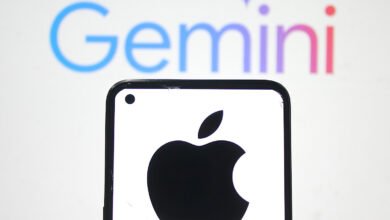Apple iPhone Air: Surprisingly Impressive

▼ Summary
– The iPhone Air is significantly thinner and lighter than the iPhone 17 Pro, measuring 5.6 mm thick and weighing 165 grams compared to the Pro’s 8.75 mm and 206 grams.
– Despite its slim and lightweight design, the iPhone Air feels strong and durable due to its titanium frame and Ceramic Shield protection on both the display and back.
– The iPhone Air underwent rigorous bend testing, withstanding over 130 pounds of force without damage, indicating high structural integrity and no risk of a bending issue.
– The reviewer was initially skeptical about the iPhone Air’s value due to its single-camera system and potential battery life concerns but found it pleasantly surprising and suitable for early adopters.
– The camera bar on the iPhone Air protrudes enough to cause the phone to rock on a flat surface when tapped, though this is noted as a minor drawback.
Holding the new iPhone Air feels like holding a whisper. After days of carrying this impossibly light device, picking up the iPhone 17 Pro again felt like lifting a small brick. That immediate sense of reluctance to let go speaks volumes about how effectively Apple has reimagined smartphone form and feel.
A difference of just a few grams and a dramatically slimmer silhouette transforms the entire experience. The edges offer little to grip, lending the Air a delicate, almost whimsical appearance. Yet, this impression of fragility is quickly dispelled by its underlying strength. It looks like a twig that might snap, but the robust titanium frame tells a different story.
Skepticism was my initial reaction. Why create such a thin phone, especially one with a single camera and battery life that doesn’t break records, and price it at $999? After real-world use, my opinion shifted. This isn’t a device for everyone, it’s aimed squarely at early adopters eager to experience the thinnest iPhone ever made. But it serves as a compelling preview of where smartphone design is headed.
At just 5.6 millimeters thick and weighing only 165 grams, the iPhone Air stands in stark contrast to the iPhone 17 Pro, which is both thicker and heavier despite having a smaller screen. That first impression of lightness might mistakenly suggest a lack of substance, but that feeling fades fast. In hand, the Air conveys strength, rigidity, and surprising durability.
Apple demonstrated a bend test during its presentation, showing the iPhone Air withstanding over 130 pounds of force without damage. Personal testing confirmed this resilience, the device showed no flex under pressure. While real-world performance over time remains to be seen, early signs are reassuring. This structural integrity comes from a titanium frame, Ceramic Shield 2 on the display, and a layer of Ceramic Shield 1 on the back, making it more durable than any previous iPhone model.
It seems almost a shame to cover such a sleek design with a case, though Apple’s own bumper case manages to preserve much of the Air’s slim profile while improving grip. One minor annoyance persists: despite adopting a horizontal camera bar similar to Google’s Pixel phones, the lens still protrudes enough to make the phone rock slightly when placed on a flat surface. It’s a small detail, but one that reminds you this is still a device built for bold experimentation.
(Source: Wired)




